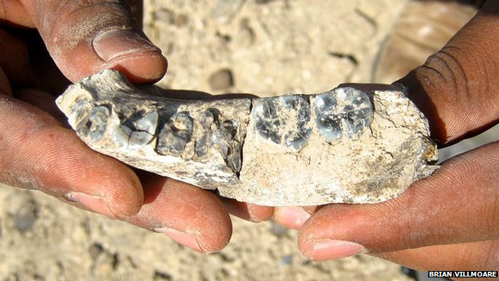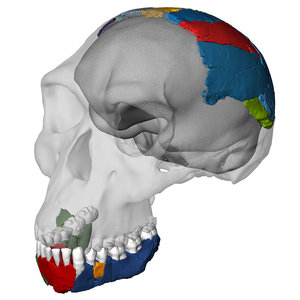The Very Complicated Human Family Tree Revealed by New Discoveries
New Research and New Discoveries Shed Light on our Ancestry
If anyone has had an opportunity to trace their family tree, then they know that given the wealth of data around today, a few clicks of the keyboard can provide a great deal of information about your family. However, when it comes to tracing the origins of the “human family”, the evolution of our own species, then things are much more tricky. New research published today in the journal “Nature” is helping to unravel the complicated journey that hominins have taken, a journey that eventually saw the emergence of our species, Homo sapiens sometime around 220,000 years ago.
Homo habilis
Using a fossilised very human-like partial jawbone found at Ledi-Geraru, (Ethiopia), which has been dated to around 2.8 million years ago, in addition with already described material, an international team of scientists have reconstructed the skull of the early hominin Homo habilis (handy man) and looked at the ancestry of this species. The research team included scientists from the University College London, in collaboration with the National Museums of Tanzania and the Max Planck Institute for Evolutionary Anthropology (Leipzig, Germany).
This new research helps to establish the human lineage and to determine what makes H. habilis so distinctive from the early Australopithecines such as the famous “Lucy” fossil – A. afarensis which ironically, was discovered not too far from where the 2.8 million year old hominin lower jaw was found. However, the fossils of “Lucy” are much older. The partial skeleton of “Lucy” has been dated to around 3.2 million years ago.
The Famous “Lucy”
To read more about an exhibition that features the remarkable preserved remains of “Lucy”: Pictures from an Exhibition.
The first fossils of “handy man”, Homo habilis were described in 1964. They consisted of a distorted lower jaw, hand bones and a highly fragmented braincase, all representing the bones of a single individual. These fossils were catalogued as Olduvai hominin (OH7). The rarity of early human bones, along with the very distorted remains associated with the earliest evidence of H. habilis made determining the unique characteristics and features of this species extremely difficult.
However, this research team utilised state-of-the-art computerised tomography and sophisticated computer modelling to unscramble the distorted remains and to piece together a reconstruction of the skull and jaws of Homo habilis.
The Human Family Tree
The question that has puzzled palaeoanthropologists since the scientific description of Homo habilis and the subsequent discovery of more Australopithecine fossil remains was, could the likes of “Lucy” have evolved into the very first human-like creatures? Professor Brian Villmoare (University of Nevada), believes that the discovery of this 2.8 million year old jaw bone, complete with five teeth helps to confirm this hypothesis.
The Fossilised Jaw Bone (2.8 million years old)
Picture credit: Brian Villmoare (University of Nevada)
The problem is this, the fossil record between the time period when “Lucy” and her kin were alive and the emergence of Homo erectus (with its relatively large brain and human-like body proportions), some two million years ago, is extremely sparse. What has been found, is also very fragmentary, making tracing evolutionary links difficult. The ancient human-like jawbone is highly significant. The molar teeth are much smaller and less robust than those of other hominins known from the fossil record. It is the size of the jaws and the teeth wherein that helps scientists to distinguish more human-like species from those which are more ape-like.
Commenting on the significance of this fossil find, scientists have stated that this new discovery pushes back the human evolutionary line by some 400,000 years or so. The fossilised jawbone with its mix of primitive and more advanced traits makes it a candidate for a transitional species between the Australopithecines and the human family tree.
The Digital Reconstruction of the Skull and Jaws of Homo Habilis
Picture credit: University College London
“Handy Man”
The “handy man” fossil material having undergone its computer modelling reveals new information about the jaw shape. The computer having reassembled the distorted jaw described in 1964, to provide a more accurate reflection of the living bone. The research published in “Nature” suggests that Homo habilis has older evolutionary roots than previously thought. This research supports the idea that many different types of Homo species existed in Africa between 2.1 and 1.6 million years ago.
Climate change, leading to a much drier, deforested habitat may have led to a spurt in evolutionary experimentation as species adapted to the new environment and exploited new niches in the changing ecosystem. The modelled lower jaw reveals primitive traits such as seen in Australopithecine fossil material, but it also has more advanced features, distinguishing H. habilis from its contemporary Homo rudolfensis.
The potential transitional link between hominins and Australopithecines remained elusive until the University of Nevada discovery of the 2.8 million year old jawbone. The fossil, known as LD 350-1 is an excellent candidate for the ancestor of Homo habilis and other early hominins.
Commenting on the fossil jawbone discovery, Dr Villmoare stated:
“LD 350-1 reveals that many of the anatomical patterns we see in two million year old Homo were established much earlier in the evolution of the genus. At 2.8 million years ago we see relatively evolved Homo traits in combination with other, much more primitive anatomical features, a result that is particularly interesting in light of the shape of the OH7 reconstruction.”



